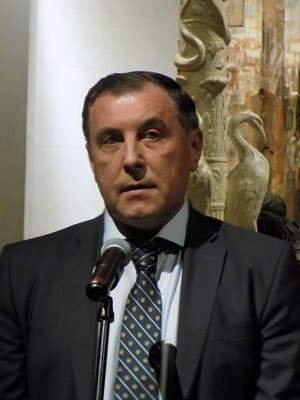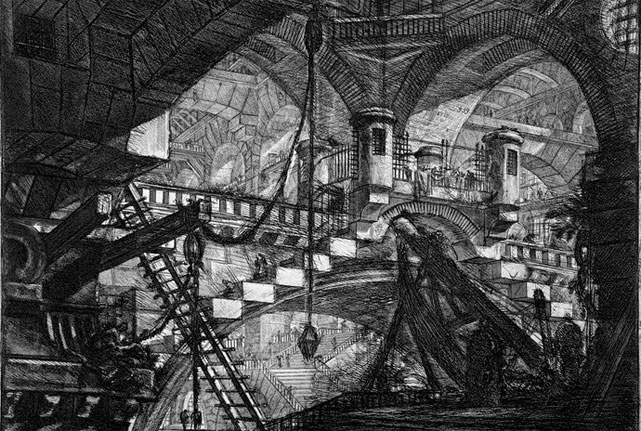Exhibition of Giovanni Battista Piranesi is held in the Museum of Fine arts of A. S. Pushkin on 20 Sep 2016 – 13 November 2016. Piranesi was an Italian man of culture, whose activities are multifaceted in nature (engraver, draughtsman, architect, vedutista, designer, academic researcher).
This Moscow exhibition covers all aspects of Piranesi. It is a part of a demonstration in Russia of the great Italian art at the initiative of the Embassy of Italy in Russia and under the sponsorship of VTB Bank.
Exposed in the museum works of the artist of the XVIII century (1720-1778 years of life) now look completely modern. There are two reasons: the first, they are out of time, how everything is in the high art. The second, the exhibition is designed so that we can see and the origins of Piranesi’s art, and modernity. The exhibition is called exactly: “Piranesi. Before and after. Italy – Russia. XVIII-XXI Centuries “.
The exhibition in the Pushkin Museum contains more than 400 exhibits, 100 etchings of Piranesi, engravings and drawings of his predecessors and successors, molds, coins, medals, books, cork models from the collection of the Scientific Research Museum of the Russian Academy of Arts, graphic sheets from the Chini Fund (Venice), Museum of architecture named after A. V. Shchusev, fund named after Jacob Chernihov and others.
You can see Italy in its ancient beauty through works of G. Piranesi at the exhibition. Hero for the day was an avid collector of antiquities and as an art expert, whose opinion to trust in the courts. He was engaged in commercial work in this direction.
Another component of his work, reflected in the exhibition – the patriotism of the Italian researcher of antiquity. His tireless research work he sought to prove that the Roman culture distinctive and not dependent on the Greek, as is commonly believed. Piranesi saw the origins of the ancient Italian culture to a greater extent in the Etruscan civilization.
Communication between the artist with modernity is twofold. Firstly, the exhibition presents the modern views of Italy. Exposure provides an opportunity to see the contrast: the etchings of Piranesi on the background of modern pictures of the same places. Despite the fact that the modern Italian photographer is an absolute professional in his field, the wizard’s of the XVIII century works are an art so high that the current prototype looks much simpler compared to them. Piranesi erected on a pedestal every detail, he spiritualized the ancient ruins by artistic techniques, and by his love he created a poetic hymns to the glory of Rome.
Secondly, that, in our opinion, can affect our compatriots, it is the refraction of ideas of the Italian architect on the Soviet architectural solutions. The general public will open inspiration sources of palaces of the Soviet era (“Stalinist Empire style”) arrayed by I. Leonidov, K. Melnikov, Y. Chernikhov and cause considerable surprise. And today the Russian artists draw inspiration from the famous Italian (V. Koshliakov).
A special place devoted to series of etchings “Imaginary dungeons” in the exhibition in which the artist fantasy on the theme of limited space is truly boundless and deeply dramatic.
In other words, the exhibition “Piranesi. Before and after. Italy – Russia. XVIII-XXI centuries” carries a lot of interesting and performs two important functions: opens us the inspiration sources of Russian culture and deeper acquaint with the high Italian culture..
We suggest you also to get acquainted with the impressions of two important participants of the exhibition – its initiator and its general sponsor, whether it met their high aims and desires.
Below you will see an interview for the cultural and political magazine “E Vesti” Italian Ambassador in Russia Cesare Maria Ragalini and Vice-President of “VTB” Bank Alexander Yurevich Yerofeyev..

EV: Mr. Ambassador, you said that the projects you initiated should increase the popularity of Italy among Russians and entice them to visit your wonderful country, learn its language. Please, tell us, are you satisfied with the way the projects were launched, devoted to Raphael and Piranesi?
Cesare M. Ragaglini: Yes, I am definitely satisfied with what we did.
In particular, it was difficult to organize an exhibition of Raphael and visit La Scala Theatre. The first project was the most difficult, because it required sending to Moscow of such works, which are very rarely leave the museum. It is possible that works will never leave those museums in which they are stored, and the Russians, perhaps the only ones who will be able to see the exhibition, composed of such masterpieces. So I have reasons to be extremely satisfied with what we did. And another thing that makes me optimistic – it is the popularity of our initiatives among the Russian public. The huge number of people has already visited Raphael exhibition, and I really hope that the Piranesi exhibition deserve the attention of Muscovites too.
I am convinced that those who have already had a chance and still happen to visit our exhibitions, and those who heard the music of La Scala Theatre, will be interested in the country that gave birth to this kind of art.
EV: When the Russians come to Italy, it is often very difficult. The average Russian tourist not always in contact with the high art when comes to you. And you bring here really the best, and this is a significant contribution to the fact order to Russians knew what to focus on in the country. What do you recommend to travelers – to our visitors?
Cesare M. Ragaglini: Firstly, you can not go to Italy and at one time see all the things that you need to see of the best of cultural values. Therefore, I think, what a person would fond of, whatever gave him pleasure, whether landscapes, art or food, it must be repeated trips that are formed over time and frequency. It might be worth to start with the main centers of Italian culture, such as Rome, Florence, Venice. But there are still a lot of places that deserve attention from the point of view of culture, and from the point of view of lanshaft. Of course, you need to expand your horizons after visiting the most famous cities. Then comes the moment when a person falls in love with Italy, so remains there forever. And all he remains – do not be lazy go for a walk every day, order to become better acquainted with the country.

EV: Alexander, please tell me whether you satisfied with the effect of the exhibition, and what more programs do you support at the moment?
Yerofeyev A. Y.: Yes, of course, we are satisfied, and you can see for yourself what a wonderful exhibition has turned out.
Of course, this is only one of the supported by us museum projects, we have an agreement with the Pushkin Museum on a permanent sponsorship, although earlier we assisted the museum, but from time to time.
We also introduced a collection of collector Silberstein, in June – exhibition “Cranach. Between the Renaissance and Mannerism”, Piranesi is now opened, just a week will be opened the exhibition “Albert Marquet. Opened window. The works from Russian and French museums and private collections. ”
EV: What aim is the bank set for its sponsorship in such projects?
Yerofeyev A. Y.: There are sponsorship and charitable activities, so any commercial benefit here we do not expect.
Management of the Bank are highly educated, intelligent and versed in art. Andrey Leonidovich Kostin, in particular, loves poetry, art, painting, so working with museums is put in the priority and the cornerstone of sponsorship. He’s a big fan of the Silver Age, and so even in those times when Crimea was part of Ukraine, since 2003, we restored the house-museum of M. Voloshin in Koktebel, we also work with Feodosia Museum of Tsvetayevs’ sisters for 4 years.
That is, we support the museum culture and try the best we can, how much allow the bank’s financial capabilities to do so it to become the property of Russians.
EV: You choose what you close to throughout the entire palette of cultural and museum programs? For example, why did you decide to support Piranesi, what is behind this?
Yerofeyev A. Y.: We have such a practice usually, that the museum, with whom we work, sendsits plans before the New Year. We look, we choose the most interesting and significant.
We believe so that as our bank is large, we need to choose the most important projects. We support what is interesting, significant and new to the Russians, first of all what was not there before. G. Piranesi previously had not been bring here, Cranach also hadn’t.
Support of I. Zilberstein was our (and museum) tribute and attention to the people who have dedicated their lives collecting and then do not sell, do not give away his collection, and given it to the state. A similar exhibition, supported by us for the same reason, there was an exhibition on the 100th anniversary of the Collector G. D. Kostaki in 2015 at the Tretyakov Gallery. Leaving abroad, Georgii Dionisovich left his collection as a gift to the Tretyakov Gallery.
Sources: Pushkin Museum of Fine Arts




